Abstract
Monoclonal antibody technology allows the specificity of an antibody for its antigen to be used in targeting cancer cells. Stable attachment of metal ions to antibodies by means of 'bifunctional' chelating agents can add the nuclear, physical and chemical properties of the metallic elements to these target-selective proteins. The conjugation of metals--particularly radionuclides--to monoclonal antibodies results in agents for radioimmunotherapy and other medical applications. Chelators that can hold radiometals with high stability under physiological conditions are essential to avoid excessive radiation damage to non-target cells. Derivatives of polyazamacrocycles (bearing a C-substituted functional group for antibody attachment) can exhibit remarkable kinetic inertness. We have developed a new synthetic route these macrocycles via peptide synthesis and intramolecular tosylamide ring closure. Incubation of the yttrium complex of 2-p-nitrobenzyl-1,4,7,10-tetraazacyclododecane-N,N1N",N'"-te traacetic acid (nitrobenzyl-DOTA) for 18 days in serum results in loss of so little yttrium from the complex (less than 0.5%) that the rate of loss cannot be measured under these conditions. In animal models, conjugates of this chelate with monoclonal antibodies show much lower levels of yttrium in the bone than are found with DTPA chelates prepared from the cyclic anhydride. The rates of loss of indium and cobalt from nitrobenzyl-DOTA in serum are slower than from previously studied chelates. Preliminary clinical imaging studies of 111In-labeled monoclonal antibody conjugates of DOTA show highly encouraging results.
Full text
PDF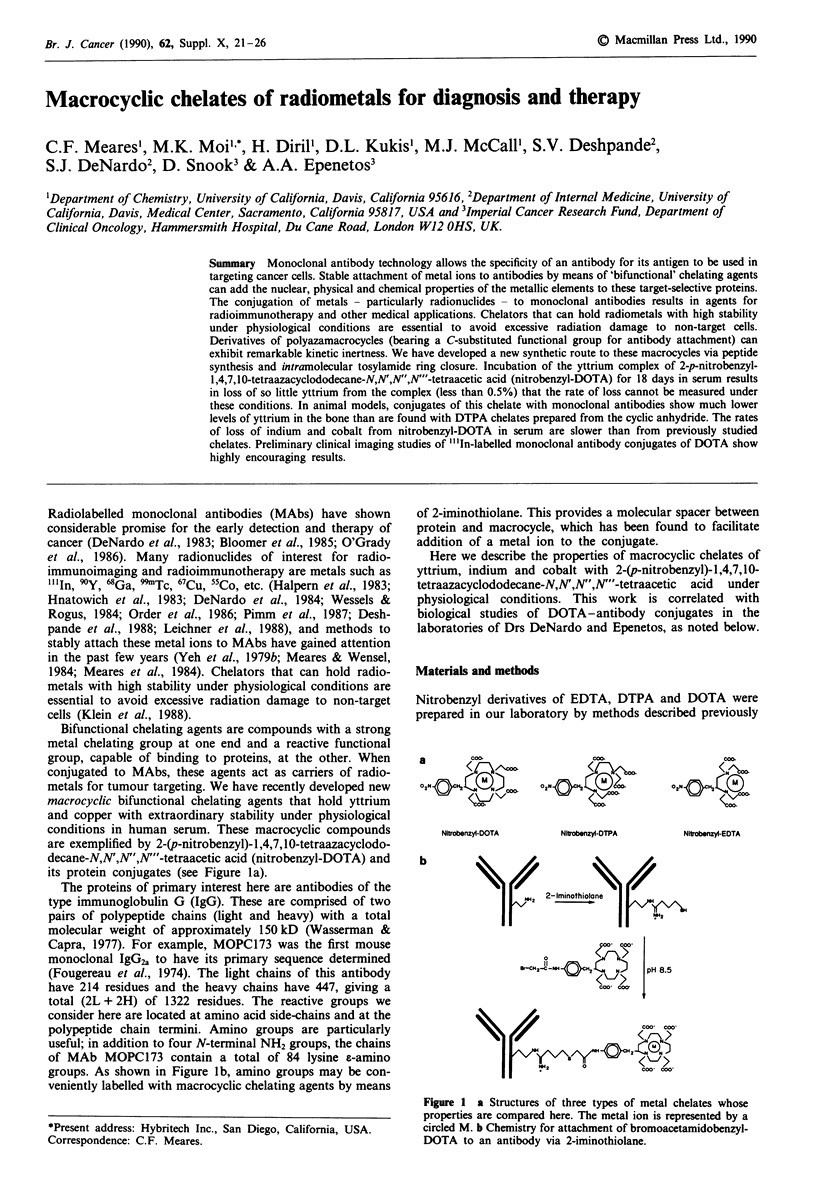

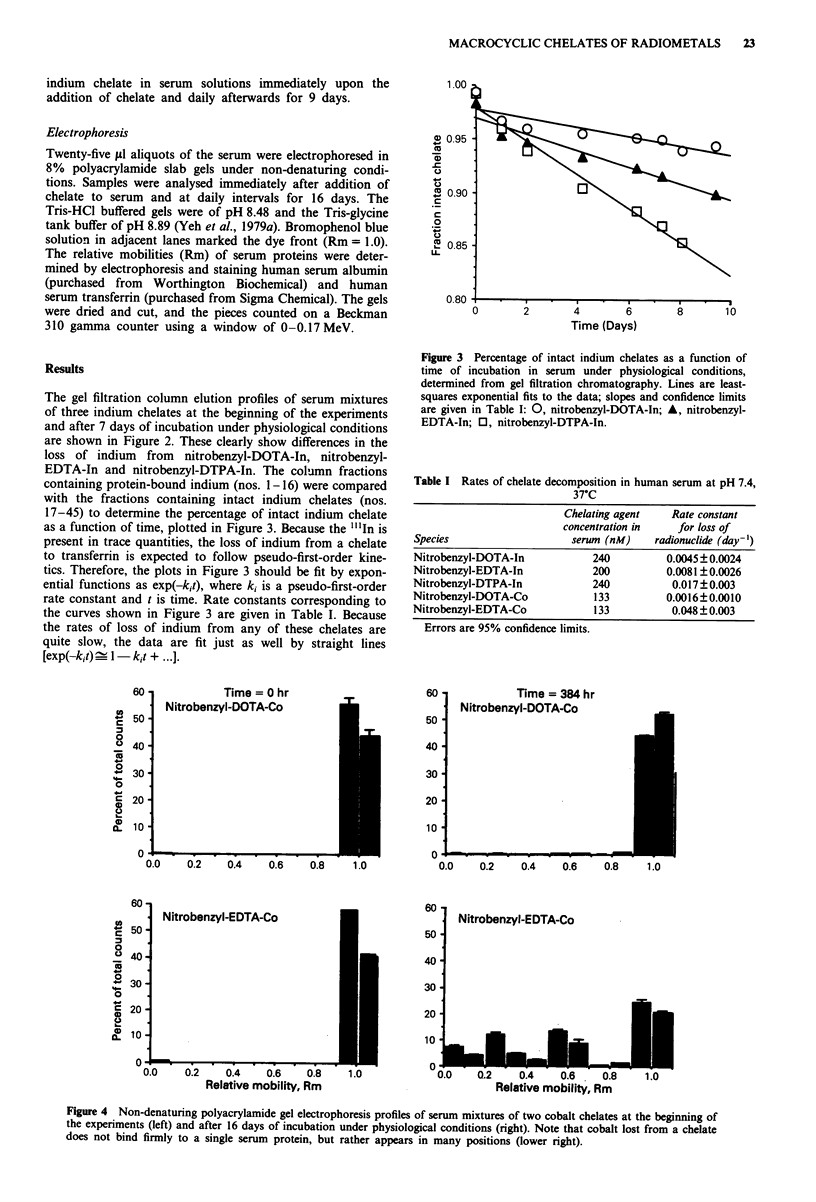
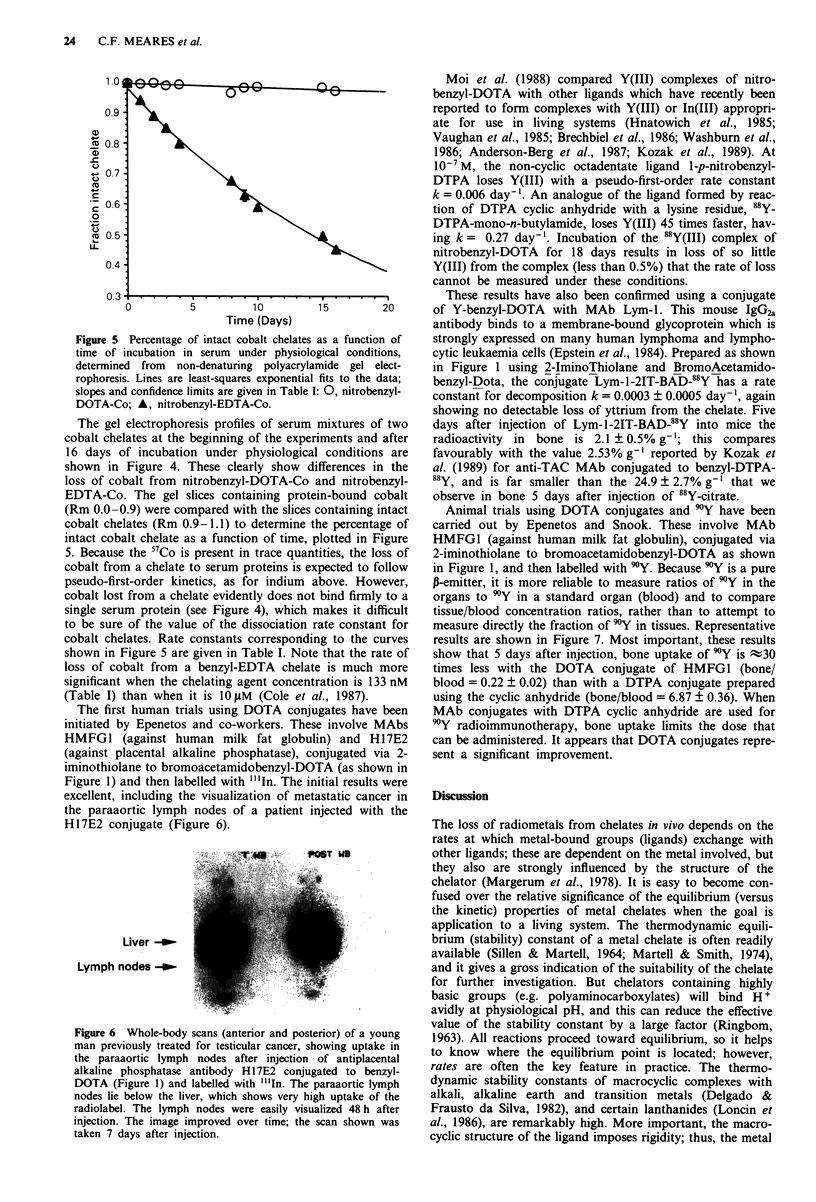
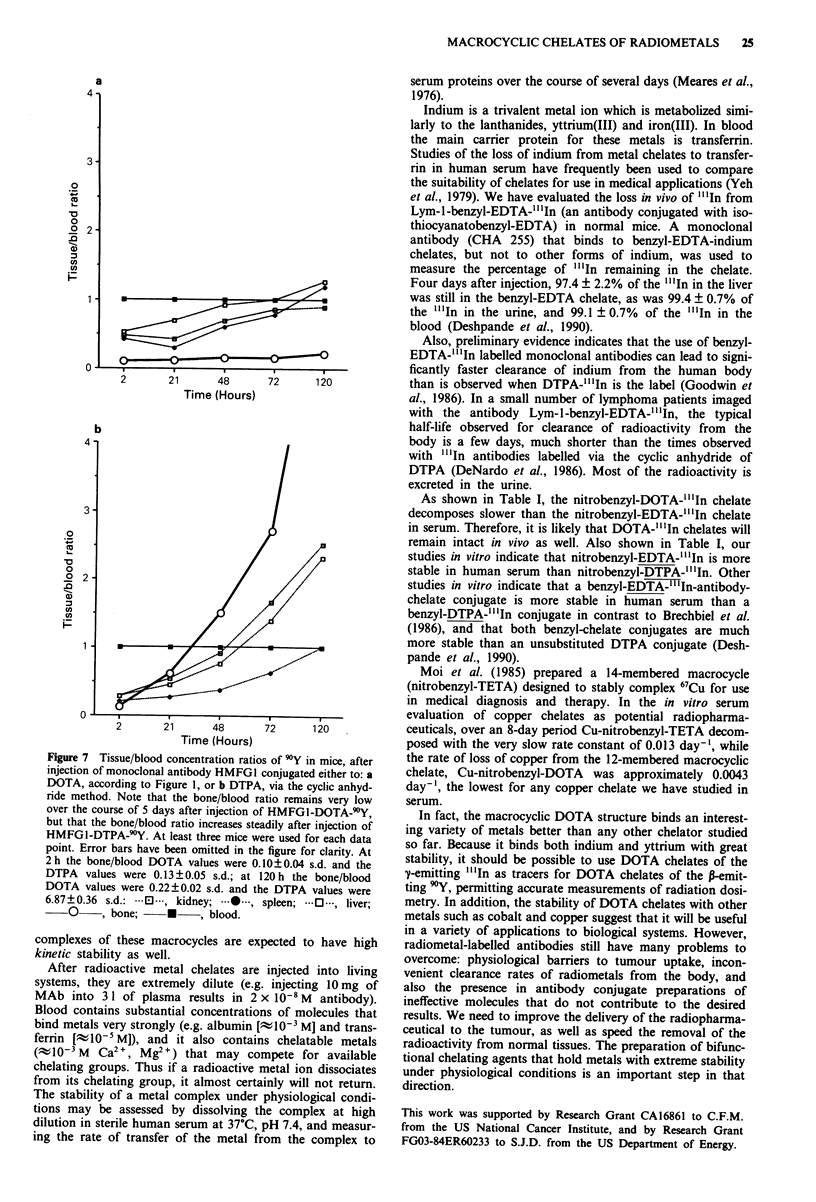
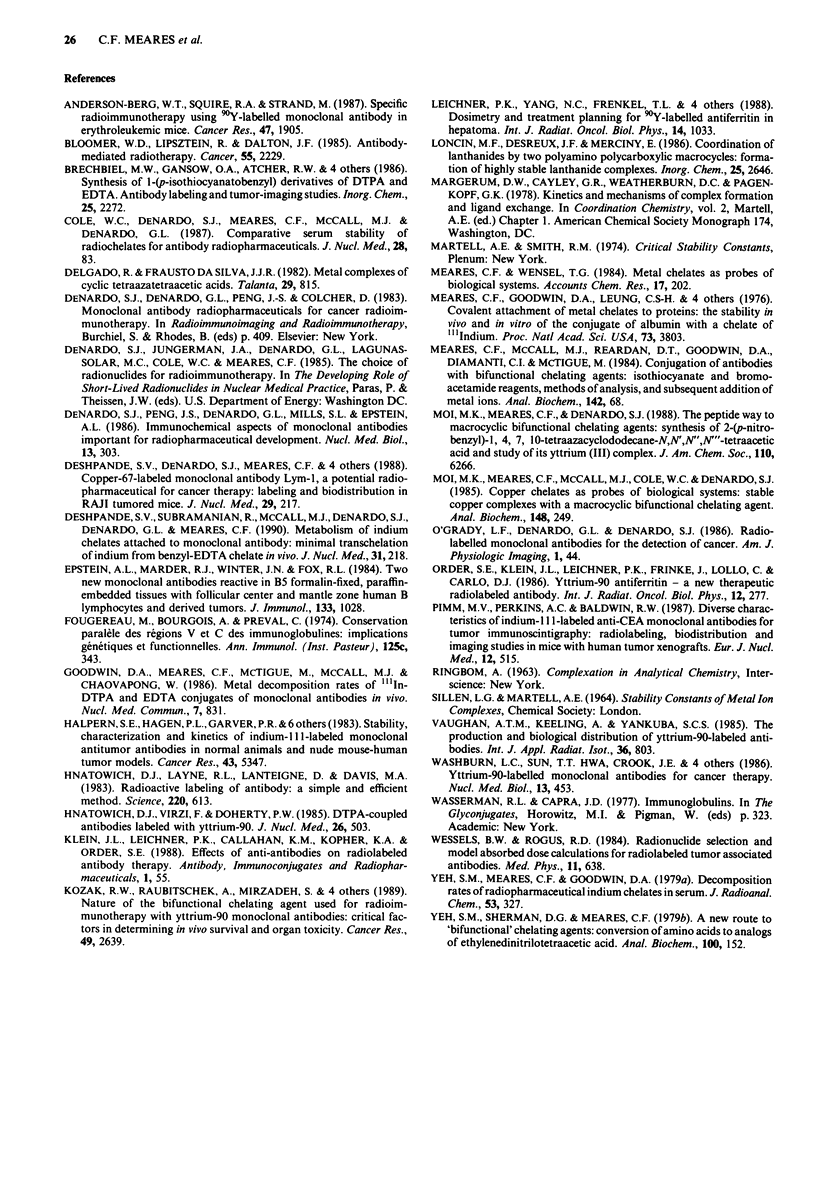
Images in this article
Selected References
These references are in PubMed. This may not be the complete list of references from this article.
- Anderson-Berg W. T., Squire R. A., Strand M. Specific radioimmunotherapy using 90Y-labeled monoclonal antibody in erythroleukemic mice. Cancer Res. 1987 Apr 1;47(7):1905–1912. [PubMed] [Google Scholar]
- Bloomer W. D., Lipsztein R., Dalton J. F. Antibody-mediated radiotherapy. Cancer. 1985 May 1;55(9 Suppl):2229–2233. doi: 10.1002/1097-0142(19850501)55:9+<2229::aid-cncr2820551427>3.0.co;2-x. [DOI] [PubMed] [Google Scholar]
- Cole W. C., DeNardo S. J., Meares C. F., McCall M. J., DeNardo G. L., Epstein A. L., O'Brien H. A., Moi M. K. Comparative serum stability of radiochelates for antibody radiopharmaceuticals. J Nucl Med. 1987 Jan;28(1):83–90. [PubMed] [Google Scholar]
- DeNardo S. J., Peng J. S., DeNardo G. L., Mills S. L., Epstein A. L. Immunochemical aspects of monoclonal antibodies important for radiopharmaceutical development. Int J Rad Appl Instrum B. 1986;13(4):303–310. doi: 10.1016/0883-2897(86)90002-4. [DOI] [PubMed] [Google Scholar]
- Deshpande S. V., DeNardo S. J., Meares C. F., McCall M. J., Adams G. P., Moi M. K., DeNardo G. L. Copper-67-labeled monoclonal antibody Lym-1, a potential radiopharmaceutical for cancer therapy: labeling and biodistribution in RAJI tumored mice. J Nucl Med. 1988 Feb;29(2):217–225. [PubMed] [Google Scholar]
- Deshpande S. V., Subramanian R., McCall M. J., DeNardo S. J., DeNardo G. L., Meares C. F. Metabolism of indium chelates attached to monoclonal antibody: minimal transchelation of indium from benzyl-EDTA chelate in vivo. J Nucl Med. 1990 Feb;31(2):218–224. [PubMed] [Google Scholar]
- Epstein A. L., Marder R. J., Winter J. N., Fox R. I. Two new monoclonal antibodies (LN-1, LN-2) reactive in B5 formalin-fixed, paraffin-embedded tissues with follicular center and mantle zone human B lymphocytes and derived tumors. J Immunol. 1984 Aug;133(2):1028–1036. [PubMed] [Google Scholar]
- Fougereau M., Bourgois A., de Preval C. Conservation parallèle des régions V et C des immunoglobulines: implications génétiques et fonctionnelles. Ann Immunol (Paris) 1974 Jan;125C(1-2):343–349. [PubMed] [Google Scholar]
- Goodwin D. A., Meares C. F., McTigue M., McCall M. J., Chaovapong W. Metal decomposition rates of 111In-DTPA and EDTA conjugates of monoclonal antibodies in vivo. Nucl Med Commun. 1986 Nov;7(11):831–838. doi: 10.1097/00006231-198611000-00006. [DOI] [PubMed] [Google Scholar]
- Halpern S. E., Hagan P. L., Garver P. R., Koziol J. A., Chen A. W., Frincke J. M., Bartholomew R. M., David G. S., Adams T. H. Stability, characterization, and kinetics of 111In-labeled monoclonal antitumor antibodies in normal animals and nude mouse-human tumor models. Cancer Res. 1983 Nov;43(11):5347–5355. [PubMed] [Google Scholar]
- Hnatowich D. J., Layne W. W., Childs R. L., Lanteigne D., Davis M. A., Griffin T. W., Doherty P. W. Radioactive labeling of antibody: a simple and efficient method. Science. 1983 May 6;220(4597):613–615. doi: 10.1126/science.6836304. [DOI] [PubMed] [Google Scholar]
- Hnatowich D. J., Virzi F., Doherty P. W. DTPA-coupled antibodies labeled with yttrium-90. J Nucl Med. 1985 May;26(5):503–509. [PubMed] [Google Scholar]
- Kozak R. W., Raubitschek A., Mirzadeh S., Brechbiel M. W., Junghans R. P., Gansow O. A., Waldmann T. A., Junghaus R. Nature of the bifunctional chelating agent used for radioimmunotherapy with yttrium-90 monoclonal antibodies: critical factors in determining in vivo survival and organ toxicity. Cancer Res. 1989 May 15;49(10):2639–2644. [PubMed] [Google Scholar]
- Leichner P. K., Yang N. C., Frenkel T. L., Loudenslager D. M., Hawkins W. G., Klein J. L., Order S. E. Dosimetry and treatment planning for 90Y-labeled antiferritin in hepatoma. Int J Radiat Oncol Biol Phys. 1988 May;14(5):1033–1042. doi: 10.1016/0360-3016(88)90029-6. [DOI] [PubMed] [Google Scholar]
- Meares C. F., Goodwin D. A., Leung C. S., Girgis A. Y., Silvester D. J., Nunn A. D., Lavender P. J. Covalent attachment of metal chelates to proteins:the stability in vivo and in vitro of the conjugate of albumin with a chelate of 111indium. Proc Natl Acad Sci U S A. 1976 Nov;73(11):3803–3806. doi: 10.1073/pnas.73.11.3803. [DOI] [PMC free article] [PubMed] [Google Scholar]
- Meares C. F., McCall M. J., Reardan D. T., Goodwin D. A., Diamanti C. I., McTigue M. Conjugation of antibodies with bifunctional chelating agents: isothiocyanate and bromoacetamide reagents, methods of analysis, and subsequent addition of metal ions. Anal Biochem. 1984 Oct;142(1):68–78. doi: 10.1016/0003-2697(84)90517-7. [DOI] [PubMed] [Google Scholar]
- Moi M. K., Meares C. F., McCall M. J., Cole W. C., DeNardo S. J. Copper chelates as probes of biological systems: stable copper complexes with a macrocyclic bifunctional chelating agent. Anal Biochem. 1985 Jul;148(1):249–253. doi: 10.1016/0003-2697(85)90653-0. [DOI] [PubMed] [Google Scholar]
- O'Grady L. F., DeNardo G., DeNardo S. Radiolabelled monoclonal antibodies for the detection of cancer. Am J Physiol Imaging. 1986;1(1):44–53. [PubMed] [Google Scholar]
- Order S. E., Klein J. L., Leichner P. K., Frincke J., Lollo C., Carlo D. J. 90Yttrium antiferritin--a new therapeutic radiolabeled antibody. Int J Radiat Oncol Biol Phys. 1986 Feb;12(2):277–281. doi: 10.1016/0360-3016(86)90110-0. [DOI] [PubMed] [Google Scholar]
- Pimm M. V., Perkins A. C., Baldwin R. W. Diverse characteristics of 111In labelled anti-CEA monoclonal antibodies for tumour immunoscintigraphy: radiolabelling, biodistribution and imaging studies in mice with human tumour xenografts. Eur J Nucl Med. 1987;12(10):515–521. doi: 10.1007/BF00620477. [DOI] [PubMed] [Google Scholar]
- Vaughan A. T., Keeling A., Yankuba S. C. The production and biological distribution of yttrium-90 labelled antibodies. Int J Appl Radiat Isot. 1985 Oct;36(10):803–806. doi: 10.1016/0020-708x(85)90031-6. [DOI] [PubMed] [Google Scholar]
- Washburn L. C., Hwa Sun T. T., Crook J. E., Byrd B. L., Carlton J. E., Hung Y. W., Steplewski Z. S. 90Y-labeled monoclonal antibodies for cancer therapy. Int J Rad Appl Instrum B. 1986;13(4):453–456. doi: 10.1016/0883-2897(86)90024-3. [DOI] [PubMed] [Google Scholar]
- Wessels B. W., Rogus R. D. Radionuclide selection and model absorbed dose calculations for radiolabeled tumor associated antibodies. Med Phys. 1984 Sep-Oct;11(5):638–645. doi: 10.1118/1.595559. [DOI] [PubMed] [Google Scholar]
- Yeh S. M., Sherman D. G., Meares C. F. A new route to "bifunctional" chelating agents: conversion of amino acids to analogs of ethylenedinitrilotetraacetic acid. Anal Biochem. 1979 Nov 15;100(1):152–159. doi: 10.1016/0003-2697(79)90125-8. [DOI] [PubMed] [Google Scholar]



